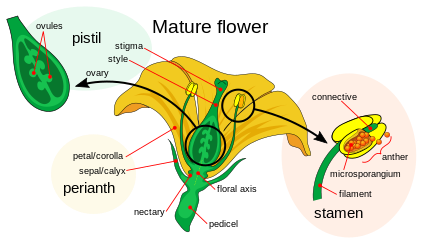 |
| Crocus sativus |
Saffron comes from a flowering bulb, called Crocus sativus. If you recognize the name, the crocus is a family of popular flowering bulbs. Crocus are neat because some of them grow vegetative material (leaves) in the spring to store carbohydrates, lose the leaves over the summer, then produce flowers without leaves in the fall. One of my favorite crocus is the Naked Lady, which produces really long flowering stocks that seemingly come out of nowhere.
Each Crocus sativus flower grows from a crom (which is an underground stem, like a bulb), which will produce up to four flowers each year. Each of the flowers grows things in multiples of three - six petals, three male parts, and three female parts. This diagram shows the exact terminology of these plat parts. In the saffron crocus, the stigma extends beyond the petals of the flower, creating the saffron threads. This means that for each flower, three threads of saffron can be harvested. Per plant, you can harvest a total of twelve threads per year if optimal conditions persist. In total, a pound of dry saffron takes 50,000-75,000 flowers - roughly a football sized field of them. Additionally, each thread must be hand picked upon harvesting and quickly dealt with to preserve flavor and quality. It's a lot of work, which further explains it's high cost of production.
 |
| Impostor saffron - Colchicum autumnale, a Naked Lady |
Saffron can be easily grown in your backyard by selecting and planting the specific saffron crocus, but be warned that not all crocus grow edible stigma threads. In fact, the Naked Lady mentioned above can grow very similar looking stigma threads that are quite toxic.

nice. Thanks for explaining it. now i can cut off each cook's head that desregards the value of saffron. What can we do to preserve it when we have it in the kitchen?
ReplyDeletePretty flowers
ReplyDelete